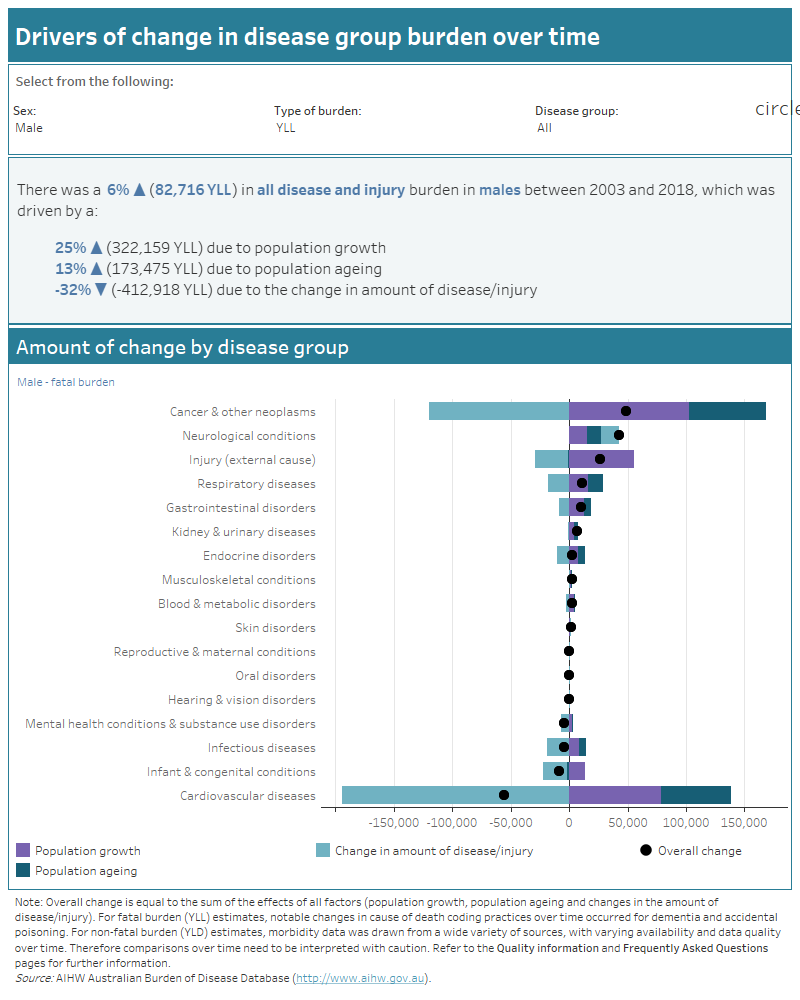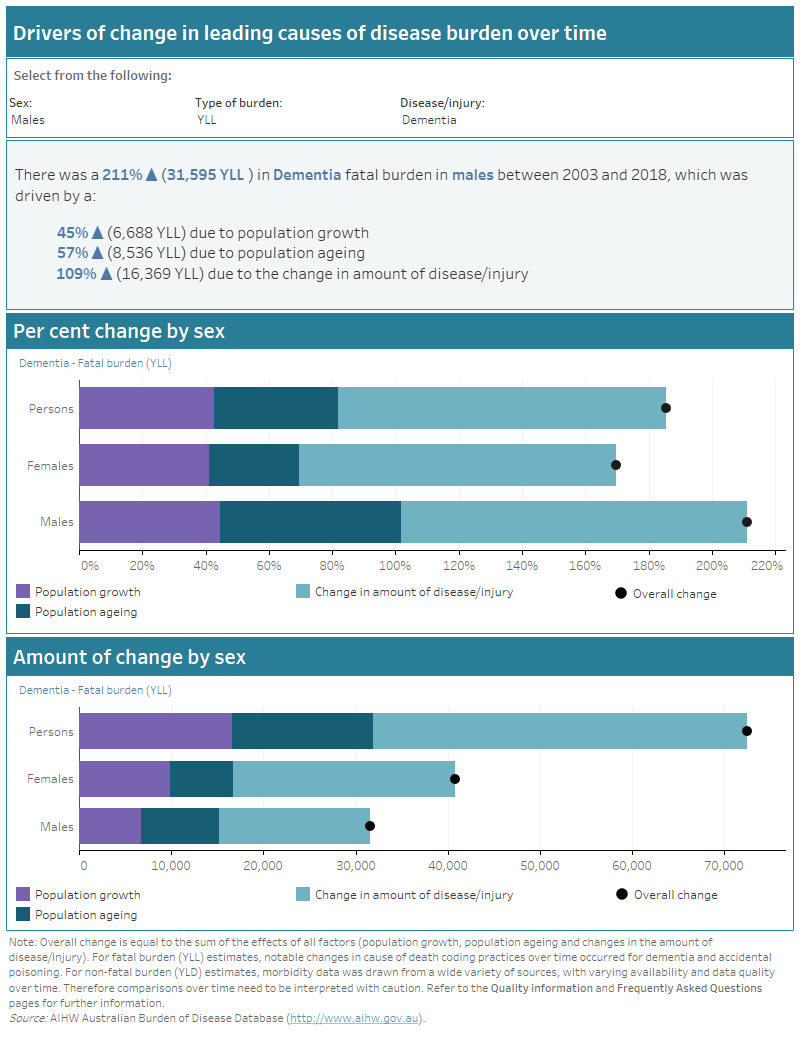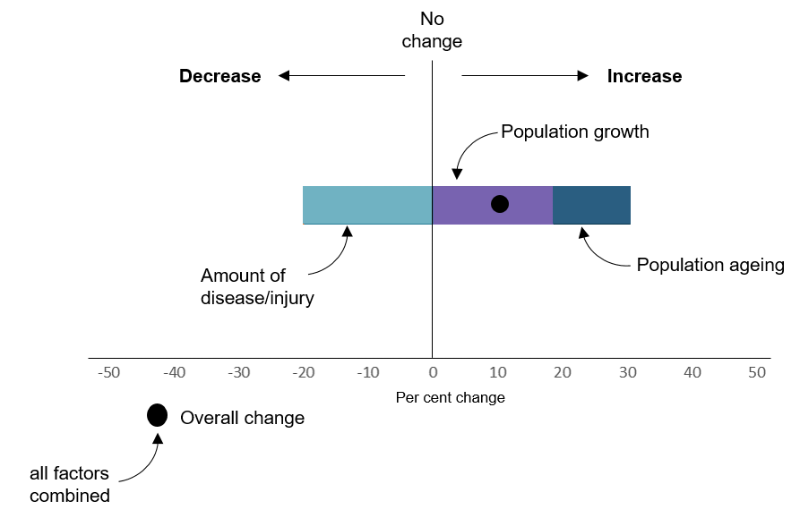Drivers of change in disease burden
This section presents analyses undertaken to explore the different drivers of change in disease burden over time.
Between 2003 and 2018, there was a 20% increase in the total number of DALY in Australia, from 4.2 million to 5.0 million DALY. Note this is different to changes in the age-standardised rate of DALY per 1,000 population which decreased from 209 DALY per 1,000 in 2003 to 182 DALY per 1,000 in 2018.
The main factors contributing to the change in the total number of DALY were population growth (the Australian population increased by 26% between 2003 and 2018), population ageing, and changes in the amount of disease and injury in the population. These 3 factors and the method used to estimate the contribution of each factor to changes in disease burden are explained further in the box below.
Key results from these analyses can be found in the data visualisations below and in Table S1 in the ABDS 2018 Drivers of change in disease burden data table.
Three factors contributing to changes in disease burden over time were included in these analyses:
- population growth—in Australia population size is increasing over time
- population ageing—in Australia the age structure of the population is changing, with the proportion of older people increasing over time
- change in amount of disease/injury—estimated by the prevalence of the disease, the number of deaths and the average age at death. This can be influenced by changes in diagnosis, treatment or survival (resulting in increases or decreases in prevalence and changes in the severity of the disease), and variation in exposure to risk factors linked to the disease.
These factors were selected as they are the main drivers of trends in disease burden examined in global burden of disease studies and are measurable with available data. It was not possible to include other factors such as socioeconomic status or estimate the contribution of risk factors to the overall change in disease burden (only to the change in attributable burden—see the drivers of change over time page in the ABDS 2018 interactive data on risk factor burden).
In this analysis, the contribution of each of the 3 factors to the change in fatal, non-fatal and total burden between 2003 and 2018 were estimated using methods developed by Das Gupta (Das Gupta 1993). This method considers the size of each factor and the interactions between them.
Each factor may cause burden to increase (indicated by a positive factor of change) or decrease (a negative factor of change) over time. The sum of the effect of all factors represents the overall change in burden between 2003 and 2018. This is expressed as the amount of change (DALY, YLL or YLD) or as a percentage of the change due to the factor. Although 2011 and 2015 data are also available, 2003 and 2018 were chosen as the comparison time points to enable the longest possible time series.
For most disease groups, DALY numbers were higher in 2018 compared to 2003, largely reflecting increases in population and ageing. The exceptions were cardiovascular diseases, infectious diseases and infant & congenital conditions which had a decline in DALY, mainly due to a reduction in the amount of disease.
Use the interactive text and graph below to explore the different drivers of change in burden (DALY, YLD or YLL) by sex and disease group in Australia between 2003 and 2018.
For more interactive data on changes in age-standardised rates of burden over time, see comparisons over time.
This interactive data visualisation reports on the drivers of change in disease burden in Australia between 2003 and 2018 for each of the 17 disease groups. There are 2 sections which can be customised to report data according to type of burden, sex and disease group. The first section is a text box which reports the total amount of change and the total percent change in disease burden between 2003 and 2018 for the selected type of burden, sex and disease group. The text box also reports the amount of change and the percent change due to each of the 3 drivers of change for the selected type of burden, sex and disease group. The second section is a stacked horizontal bar chart which shows the amount of change in burden due to each of the 3 drivers of change, as well as the total amount of change in burden, for each disease group for the selected type of burden and sex. Each bar corresponds to a different disease group and the bar is shaded to represent each driver of change. The total amount of change is marked on the bar with a large dot. Depending on the disease group, the horizontal axis may extend to the left to represent a decrease in burden and to the right to represent an increase in burden. The vertical axis crosses at 0 (no change in burden).

Please use the ‘Download’ button at the bottom of the dashboard to generate image or PDF versions of the data.
The change in disease burden over time shows a different pattern depending on the leading cause selected and the type of burden (DALY, YLL or YLD). For example, DALY has decreased for coronary heart disease and stroke, mainly driven by large declines in the amount of disease for both fatal (YLL) and non-fatal (YLD) burden. In contrast, there has been an increase in the amount of burden due to dementia, which is largely driven by increases in the amount of disease for fatal burden (partly due to changes in death coding practices over the period).
Use the interactive text and graph below to explore the different drivers of change in burden (DALY, YLD or YLL) by sex for the top 50 (by DALY) specific diseases or injuries in Australia between 2003 and 2018 (ordered by diseases with highest to lowest burden in 2018).
For more interactive data on changes in age-standardised rates of burden over time, see comparisons over time.
This interactive data visualisation reports on the drivers of change in disease burden in Australia between 2003 and 2018 for each of the leading 50 diseases according to total burden in 2018. There are 3 sections which can be customised to report data according to type of burden, sex and disease or injury. The first section is a text box which reports the total amount of change and the total percent change in disease burden between 2003 and 2018 for the selected type of burden, sex and disease or injury. The text box also reports the amount of change and the percent change due to each of the 3 drivers of change for the selected type of burden, sex and disease or injury. The second and third section are stacked horizontal bar charts. The first chart shows the per cent change in burden due to each of the 3 drivers of change, as well as the total per cent change in burden, for the selected type of burden and disease or injury. The second chart shows the amount of change in burden due to each of the 3 drivers of change as well, as the total amount of change in burden, for the selected type of burden and disease or injury. Each chart has 3 bars which corresponds to males, females and persons. The bars are shaded to represent each driver of change. The total amount of change is marked on the bar with a large dot. Depending on the disease or injury, the horizontal axis may extend to the left to represent a decrease in burden and to the right to represent an increase in burden. The vertical axis crosses at 0 (no change in burden).

Frequently asked questions
How should the drivers of change over time analyses and charts be interpreted?
The figure below is provided to help readers interpret the analyses and charts presented in this web release. Each factor included in the drivers of change over time analyses (population growth, population ageing and amount of disease/injury) may cause the overall disease burden to increase (indicated by a positive percent change) or decrease (a negative percentage change) over time. The sum of the effect of all factors represents the overall change in disease burden between 2003 and 2018.

Put simply, these analyses show that if the overall burden due to a disease or injury is increasing (i.e. getting worse), we can see which factors are most responsible for this increase and target policy and program responses accordingly.
How are the estimates of drivers of change over time calculated?
The Das Gupta method was used to decompose the changes in burden attributable to each disease group, disease or injury into 3 additive components (Das Gupta 1993). Using a series of scenarios this method calculates the effect of each factor on the changes over time by assuming that all other factors, except the factor under consideration, remain the same at both time points. This provides an indication of the proportionate impact of the specified factors (assuming any other unspecified factors are small and independent of the specific factors). The method distributes the interaction effects (such as the relationship between an ageing population and disease burden) between the factors in proportion to the strength of the main effects (Zhai et al. 2017). This differs to the stepwise approach which requires a logical order to be chosen for the factors to be included in the analyses, and would give a different result if the factors are included in a different order.
The change in overall disease burden is decomposed into changes due to:
- population growth—in Australia population size is increasing over time
- population ageing—in Australia the proportion of older people is increasing over time
- change in amount of disease/injury—estimated by the prevalence of the disease, the number of deaths and the average age at death. This can be influenced by changes in diagnosis, treatment or survival (resulting in increases or decreases in prevalence and changes in the severity of the disease), and variation in exposure to risk factors linked to the disease.
Burden is estimated as the product of these 3 factors using the formula:

where
Bt is the amount of burden (DALY, YLL or YLD) for a particular disease group, disease or injury at time point t.
j is an age and sex group
m is the age and sex groups included (males and females aged 0 to 100+)
t is a time point
Pt is the total population size at time t
Sjt is the share of the population in age and sex group j at the time t
Rjt is the rate burden for disease/injury in the age and sex group j at the time t.
∑ is the sum of all the age and sex groups j
The effect of each of the 3 factors—population size, population ageing and disease amount—using this method on the change in disease burden between 2003 and 2018 is calculated as:


where
EA is the effect of factor A (population size, population ageing and disease burden)
B is the amount of burden (DALY, YLL or YLD) due to disease/injury or disease group in 2003 (B03) in 2018 (B18)
P is the population size in 2003 (P03) or in 2018 (P18)
S is the population age structure in 2003 (S03) or in 2018 (S18)
R is the rate burden of the disease/injury of disease group in 2003 (R03) or in 2018 (R18)
What are the limitations of the methods used in this analysis?
Only factors that could be easily measured (population ageing, population growth and changes in disease/injury) were included in these analyses. However, these are considered to be among the most important drivers of change in disease burden over time. It is not possible to include other factors in the analyses that may also have an impact on changes in disease burden over time as they are not able to be quantified.
Using this methodology, it was not possible to estimate the contribution of risk factor exposure to the change in total disease burden for each disease/injury. Analysis to estimate the contribution of risk factor exposure to the change in attributable burden, however, has been undertaken and this can be found in Risk factor attributable burden: drivers of change over time.
How do these estimates of drivers of change compare to age-standardised rates?
Both age-standardised rates (which use a 'standard' population to produce rates that can be compared independent of the age structure of the study population(s)) and the drivers of change estimates presented here are methods used to compare rates over time, while taking into account the differing age structures (population ageing) of the population over time.
The percent change in age-standardised rates over time is somewhat comparable to the measure of percent change due to the amount of disease/injury in the drivers of change estimates. However, the advantage of the drivers of change estimates is that they provide an indication of the proportionate impact of each of the specified factors, not just the change in age-standardised population rates. A disadvantage of age-standardised rates is that they are only useful for the purposes of comparison with other standardised rates which have used the same reference population. Once standardised, the rates no longer reflect the actual rate observed in the population.
How accurate are the estimates for changes in disease/injury over time?
The accuracy of the estimates for changes in disease/injury over time are impacted by the quality of the mortality and morbidity data used in the calculation of the fatal (YLL) and non-fatal burden (YLD) estimates underpinning these calculations.
For fatal burden (YLL) estimates, there have been notable changes in cause of death coding practices over time for dementia and accidental poisoning and these estimates should be interpreted with caution.
For non-fatal burden (YLD) estimates, morbidity data were drawn from a wide variety of sources, with varying availability and data quality over time. Refer to the Quality information for YLD estimates from the Australian Burden of Disease Study (ABDS) 2018 for further information.
Why is there no change in the amount of disease/injury over time for some diseases?
For some diseases/injuries in ABDS 2018, data were not available on changes in prevalence over time, and based on expert advice the same age-specific prevalence rates were applied in each year (2003, 2011, 2015, 2018) of the study. As a result, there is a ‘0%’ value shown in the visualisations for the ‘amount of disease/injury’ for YLD. The overall percentage change is driven by population ageing and population growth alone. These diseases/injuries highlight data gaps and areas for future improvement and include many of the mental and substance use disorders (anxiety disorders, alcohol use disorders, bipolar affective disorder, depressive disorders, schizophrenia), as well as Parkinson disease and dermatitis and eczema.

References
Das Gupta P 1993. Standardization and decomposition of rates: a user's manual. U.S. Bureau of the Census, Current Population Reports, Series P23-186. Washington, DC: U.S. Government Printing Office.
Zhai T, Goss J, Li J 2017. Main drivers of health expenditure growth in China: a decomposition analysis. BMC Health Services Research 17(1): 185. doi:10.1186/s12913-017-2119-1. https://doi.org/10.1186/s12913-017-2119-1
Acknowledgments
The authors would like to acknowledge John Goss and Jinjing Li from the University of Canberra for providing us with an analytical tool and advice to be able to break down results over time, using the method developed by Prithwis Das Gupta.


